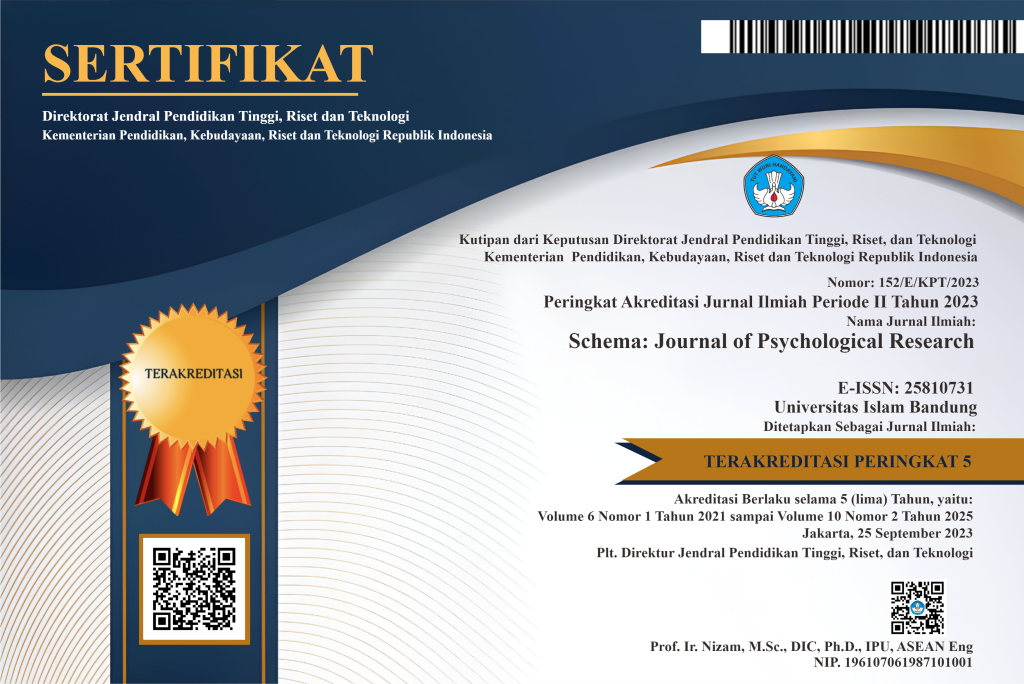Efektivitas Problem Solving Therapy Untuk Meningkatkan Kemampuan Regulasi Emosi
Abstract
Self injury merupakan tindakan menyakiti diri tanpa niatan bunuh diri. Perilaku self injury sering dilihat sebagai cara mengelola emosi atau disebut regulasi emosi (Chapman AL, Gratz KL, Brown MZ, 2006). Rendahnya regulasi emosi terlihat dari perilaku bermasalah, seperti kurangnya kontrol impuls ketika marah dan kesal (Gratz&Roemer, 2004). Problem Solving Therapy telah efektif membantu berbagai masalah, seperti depresi, kecemasan, hipertensi, dan gangguan PTSD (D'Zurilla & Nezu, 2007). Namun belum pernah diujicobakan terhadap regulasi emosi pada subjek dengan perilaku self injury. Rancangan penelitian yang digunakan adalah eksperimen subjek tunggal dengan desain A-B. Alat untuk mengukur regulasi emosi adalah Difficulties in Emotion Regulation Questionnaire dari Gratz & Roemer. Teknik pengambilan sampel yang digunakan adalah purposive sampling. Hasil intervensi menunjukan jika Problem Solving Therapy efektif dalam meningkatkan regulasi emosi pada subjek yang melakukan self injury yang terlihat dari menurunnya tingkat kesulitan meregulasi emosi dan berhentinya perilaku self injury pada subjek penelitian.
Keywords
Full Text:
PDFReferences
Chapman, A., Gratz, K.L., & Brown, M.Z. (2006). Solving the puzzle of deliberate self-harm: The experiential avoidance model. Behaviour Research and Therapy, 44. 371-391
D’Zurilla, T. & Nezu, A. (2007). Problem-solving therapy: A positive approach to clinical intervention. 3rd edn. New York: Springer Publishing Co.
Gratz, D. T., & Roemer, J. J. (2004). Antecendent and Response Focused Emotion Regulation: Divergent Consequences for Experience, Expression and Physiology. Journal of Personality and Social Psychology. 74. 224-237.
Gratz, K. L. & Roemer, L. (2004). Multidimensional assessment of emotion regulation and dysregulation: Development, factor structure, and initial validation of the Difficulties in Emotion Regulation Scale. Journal of Psychopathology and Behavioral Assessment, 26, 41-54.
Hawton, et al. (2016). Psychosocial interventions for self-harm in adults. Cochrane Database of Systematic Reviews 2016, Issue 5. Art. No.: CD012189. DOI: 10.1002/14651858.CD012189.
Hilt & Cha. (2008). Nonsuicidal Self-Injury in Young Adolescent Girls: Moderators of the Distress–Function Relationship. Vol. 76. No. 1 (63-71). Journal of Consulting and Clinical Psychology.
Kanan, et al. (2008). Self-Injury and Youth: Best Practices for School Intervention. Journal of Mental Health. 2: 67–79: Cherry Creek School District Greenwood Village, Colorado.
Klonsky, E.D., & Muehlenkamp, J.J. (2007). Self-injury: A research review for the Practitioner. Journal of Clinical Psychology: In Session, 63, 1045-1056.
Walsh, B. (2007). Clinical assessment of self-injury: A practical guide. Journal of Clinical Psychology: In Session, 63. 1057-1068.
DOI: https://doi.org/10.29313/schema.v0i0.5002
Refbacks
- There are currently no refbacks.
Indexed by:
This work is licensed under a Creative Commons Attribution-NonCommercial-ShareAlike 4.0 International License.












